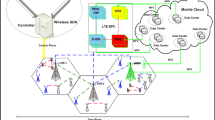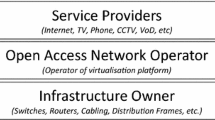Abstract
5G networks are slated to provide a wide range of services. A critical need in service delivery in 5G networks is its resilience. In this work, we present a 5G network architecture with network virtualization in a multiple provider setting for network resilience that uses a self-organizing ad hoc network among the gNBs (macrosites). Thus, the primary provider for a 5G network may use a secondary provider for network resilience when network components fail. We present an optimization formulation and a heuristic for network survivability for our proposed 5G network for the primary network provider. Through simulations, we show our proposed heuristic is very close to optimal. The simulation results on the trade-off between using a provider’s own network or rely on auxiliary capacity from another provider allow us to see the trade-off on availability. Finally, we study how priority can be provided for certain traffic groups for service survivability.



















Similar content being viewed by others
References
What is 5G? everything you need to know – a definition. https://www.sdxcentral.com/5g/definitions/what-is-5g/
Taleb, T., Ksentini, A., Sericola, B.: On service resilience in cloud-native 5G mobile systems. IEEE JSAC 34, 483–496 (2016)
Taleb, T., Corici, M., Parada, C., Jamakovic, A., Ruffino, S., Karagiannis, G., Magedanz, T.: EASE: EPC as a service to ease mobile core network deployment over cloud. IEEE Netw. 29(2), 78–88 (2015)
Charnsripinyo, C., Tipper, D.: Topological design of 3G wireless backhaul networks for service assurance. In: Proc. of 5th International Workshop on Design of Rel. Comm. Net. (DRCN) (2005)
Lemamou, E.A., Galinier, P., Chamberland, S.: A hybrid iterated local search algorithm for the global planning problem of survivable 4G wireless networks. IEEE/ACM Trans. Netw. 24, 137–148 (2016)
Chen, D., Garg, S., Trivedi, K.S.: “Network survivability performance evaluation: a quantitative approach with applications in wireless ad-hoc networks,” In: Proc. 5th ACM international workshop on Modeling analysis and simulation of wireless and mobile systems, pp. 61–68 (2002)
Abhishek, R., Zhao, S., Medhi, D.: SPArTaCuS: Service priority adaptiveness for emergency traffic in smart cities using software-defined networking. In: IEEE Smart Cities Conference (ISC2) (2016)
Alqahtani, A., Abhishek, R., Tipper, D., Medhi, D.: Disaster recovery power and communications for smart critical infrastructures. In: IEEE Intl. Conf. on Communications (ICC), (2018)
Xie, L., Heegaard, P.E., Jiang, Y.: Network survivability under disaster propagation: Modeling and analysis. In: Wireless Communications and Networking Conference (WCNC), 2013 IEEE. IEEE, pp. 4730–4735 (2013)
Diaz, O., Xu, F., Min-Allah, N., Khodeir, M., Peng, M., Khan, S., Ghani, N.: Network survivability for multiple probabilistic failures. IEEE Commun. Lett. 16(8), 1320–1323 (2012)
Sterbenz, J.P., Çetinkaya, E.K., Hameed, M.A., Jabbar, A., Qian, S., Rohrer, J.P.: Evaluation of network resilience, survivability, and disruption tolerance: analysis, topology generation, simulation, and experimentation. Telecomm. Syst. 52, 705–736 (2013)
Medhi, D., Tipper, D.: Multi-layered network survivability-models, analysis, architecture, framework and implementation: An overview. In: DARPA Information Survivability Conference and Exposition (DISCEX’00), vol. 1, pp. 173–186 (2000)
Rahman, M.M., Heydari, S.S.: A self-healing approach for LTE evolved packet core. In: 25th IEEE Canadian Conference on Electrical and Computer Engineering (CCECE) (2012)
Taleb, T., Samdanis, K.: Ensuring service resilience in the EPS: MME failure restoration case. In: IEEE GLOBECOM (2011)
Paropkari, R.A., Beard, C., Van De Liefvoort, A.: Handover performance prioritization for public safety and emergency networks. In: 2017 IEEE 38th Sarnoff Symposium, pp. 1–6 (2017)
Paropkari, R.A., Gebremichail, A.A., Beard, C.: Fractional packet duplication and fade duration outage probability analysis for handover enhancement in 5G cellular networks. In: 2019 International Conference on Computing, Networking and Communications (ICNC), pp. 298–302 (2019)
Thantharate, A., Paropkari, R., Walunj, V., Beard, C.: Deepslice: A deep learning approach towards an efficient and reliable network slicing in 5G networks. In: 2019 IEEE 10th Annual Ubiquitous Computing, Electronics and Mobile Communication Conference (UEMCON), New York, NY (October 2019)
Abhishek, R., Tipper, D., Medhi, D.: Network virtualization and survivability of 5G networks: Framework, optimization model, and performance. In: 2018 IEEE Globecom Workshops (GC Wkshps), pp. 1–6 (2018)
https://www.5tonic.org/research/5g-virtual-software-network-area
Beming, P., Frid, L., Hall, G., Malm, P., Noren, T., Olsson, M., Rune, G.: Lte-sae architecture and performance. Ericsson Rev. 3, 98–104 (2007)
Sesia, S., Baker, M., Toufik, I.: LTE-the UMTS long term evolution: from theory to practice. Wiley, New York (2011)
Ford, L., Fulkerson, D.: Maximal flow through a network. Can. J. Math. 8, 399–404 (1956)
Author information
Authors and Affiliations
Corresponding author
Additional information
Publisher's Note
Springer Nature remains neutral with regard to jurisdictional claims in published maps and institutional affiliations.
Rights and permissions
About this article
Cite this article
Abhishek, R., Tipper, D. & Medhi, D. Network Virtualization and Survivability of 5G Networks. J Netw Syst Manage 28, 923–952 (2020). https://doi.org/10.1007/s10922-020-09541-0
Received:
Revised:
Accepted:
Published:
Issue Date:
DOI: https://doi.org/10.1007/s10922-020-09541-0




